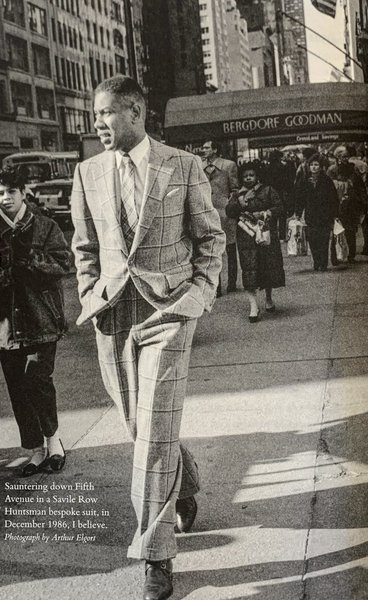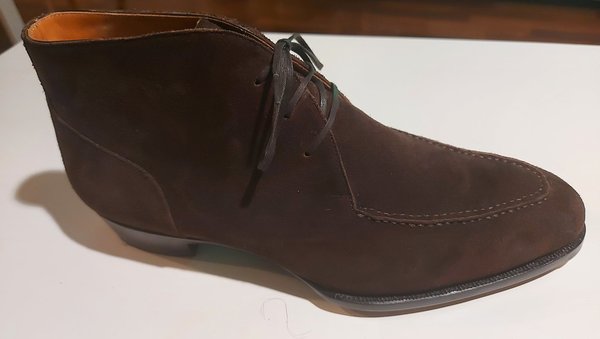shoefan
Senior Member
- Joined
- Jul 27, 2003
- Messages
- 853
- Reaction score
- 203
In my (limited) experience, the flat seam (historically called a round stitch or a split and hold stitch) is the toughest, because you are sewing halfway through both pieces of leather, and you can't 'pre-hole' the leather, you need to use the awl and then sew each stitch, one at a time. Also, you need to use two boar's bristles and have a very fine taper to the thread or you can strip the thread off the bristle. Finally, because both sides of the stitch are exiting the middle of the leather before entering the adjacent piece, it can be somewhat hard to find the hole on the opposite piece of leather with the bristle, and thus the sewing can be pretty fiddly.
The pie crust (what E. Green call skin stitching, and historically was called split and lift) is easier, since you can pre-hole the piece of leather that you are sewing parallel to the surface, then re-awl that piece of leather and pierce the thickness of the adjacent piece of leather; also, because you are only having to find the hole that is on the edge of the leather with one bristle (the one coming from the other direction), it is significantly easier to sew than the round stitch.
According to a very knowledgable shoe/bootmaker, these two stitches played different roles in the making of riding boots. The 'round' seam is used for joining two pieces of leather that are the same thickness, and has a benefit of protecting the thread from wear because of the way the leather plumps up around the thread; the pie crust stitch is used where dis-similar pieces of leather need to be joined, as trying to round stitch leather of different thickness is very problematic.
That Meccariello stitch is essentially a flat seam/skin stitch without the seam - only going halfway through the leather, and puckering up slightly when the threads are tightened, but not as puckered as a raised lake a la fig.a. Highly Technical Diagram incoming:

The split raised lake is where the whole vamp is one piece, lake and sides, and you gently score your knife around the centre of the raised area for decoration. No different to the one next to it, technically. The one from two different leathers is used for things like the pie crust; for styles that necessitate a seperate lake (longer tongues for boots or wholecut derbies); or if you want to get all fancy with contrasting leathers.
Pie crust and flat seam are the fiddliest I guess, anything where you have to get the awl to come out the middle of a cut edge of 1.2mm leather repeatedly is going to be a bit scary. Different approaches are required for each, you can use a saddlers clam for a raised lake if you like, but for a flat seam you need a curved surface and a variety of straps and clamping devices to help you get the angle right. Some people use a milk bottle glued to a plate to hold the leather on, some others prefer a different shape like a glenfiddich bottle or something. Depends what whisky you like essentially.
In my (limited) experience, the flat seam (historically called a round stitch or a split and hold stitch) is the toughest, because you are sewing halfway through both pieces of leather, and you can't 'pre-hole' the leather, you need to use the awl and then sew each stitch, one at a time. Also, you need to use two boar's bristles and have a very fine taper to the thread or you can strip the thread off the bristle. Finally, because both sides of the stitch are exiting the middle of the leather before entering the adjacent piece, it can be somewhat hard to find the hole on the opposite piece of leather with the bristle, and thus the sewing can be pretty fiddly.
The pie crust (what E. Green call skin stitching, and historically was called split and lift) is easier, since you can pre-hole the piece of leather that you are sewing parallel to the surface, then re-awl that piece of leather and pierce the thickness of the adjacent piece of leather; also, because you are only having to find the hole that is on the edge of the leather with one bristle (the one coming from the other direction), it is significantly easier to sew than the round stitch.
According to a very knowledgable shoe/bootmaker, these two stitches played different roles in the making of riding boots. The 'round' seam is used for joining two pieces of leather that are the same thickness, and has a benefit of protecting the thread from wear because of the way the leather plumps up around the thread; the pie crust stitch is used where dis-similar pieces of leather need to be joined, as trying to round stitch leather of different thickness is very problematic.
![fing02[1].gif](http://files.styleforum.net/images/smilies/fing02[1].gif)































